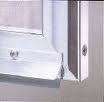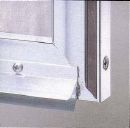 A shower door sweep is important to keep water in the shower where it belongs. Some designs though can be challenging.
A shower door sweep is important to keep water in the shower where it belongs. Some designs though can be challenging.
There are shower door sweeps that simply use a flexible rubbery flap that hangs down to block the gap between the bottom of the shower door and the shower threshold. They work fine. There are also those sweeps that have a drip rail along the door. These will have a groove along the rail that catches water as it hits the shower door and rolls down. Eventually (depending on how long of a shower you take), the groove will become full of water. When you get out of the shower, you open the door and the wonderful principle of centrifugal force takes over. As you open the hinged door, the arc of the swing flings the water on your floor.
There isn’t a whole lot you can do about that, except maybe open the door VERY gently. You might try to build a small dam at the end of the rail (on the handle side). This would at least minimize the amount of water that flies out. Try applying some silicone caulking to plug up the groove. It may even take a few applications of it to build up the height somewhat.
Flimsy shower doors are wonderful. Not only do they generate plenty of service calls, but occasionally they need to be replaced. It's a vexing double-whammy for the customer.
generate plenty of service calls, but occasionally they need to be replaced. It's a vexing double-whammy for the customer.
Most of us have the same type of shower door:a thin piece of glass surrounded by an aluminum frame. The supporting frame pieces for the door are also aluminum, and depending on the size of the opening, you may have additional glass and aluminum panels. For example, some showers have a "pony wall" with an additional piece of glass on top of it. These units are screwed and caulked together.
The door has a magnetic strip on the latch side that holds it to the other side of the frame. The opposite side of the door is hinged to a channel that you can adjust. this channel is U-shaped and it moves in and out. The whole works is held in place via the head rail that slips over the vertical framework and is screwed to each of these pieces.
You can make the necessary adjustments by removing the screws, adjusting the channel, and screwing it back together.
Before you start, you need to determine where the door needs adjusting. If your shower door is rubbing on the bottom track, you might first look at the shower "sweep," which is the rubber piece secured to the bottom of the door to keep water from splashing out. In many cases, the sweep will come loose and stop the door from opening and closing properly. Here is some information on how to repair a shower sweep.
To correct this, you can loosen the screws that hold the sweep in place, adjust the sweep back into position, and tighten the screws. If the sweep looks really nasty, a new one costs about $20.00.
If your door is rubbing on the latching side, you will have to adjust either the hinge channel or the latch channel. You need to make small adjustments and unscrew only one screw at a time.
It's always easier to adjust the latch channel because you don't have to contend with the weight of the door. The screw at the top will be driven through the head rail into the vertical channel. Unscrew this one and move it away from the door slightly.
Do the same with the bottom screw and your job just might be over. If you move the channel too much, you may have to adjust the bottom even if it wasn't part of the original problem.
If your door hits at the bottom of the opening, either move the bottom of the latch channel away from the door edge, or move the bottom of the hinge channel inward. This will fix the problem by moving the latch edge of the door downward, but you may need to adjust the top of one of the channels so you have a uniform gap. You may also need to adjust the sweep.

Many of the complaints I hear about leaking shower doors are that they leak from underneath the door.
I would like to add a complaint. Like many people, I have a glass shower door with a sweep on the bottom of it. The sweep attaches to the inside bottom of the door and has a drip edge to direct water back into the shower, and a rubber sweep on the bottom of the door to keep water from splashing out.
Now, my wife is a cleaning fanatic who goes ballistic if there is even a drop of water on the glass, so she bought a squeegee. Well, I got a little lax on squeegeeing the glass after a shower so she bought some chemicals to spray on the glass to leave a streak-free surface. Gravity pulled the chemicals down to the drip edge.
You know how when you open the door from the inside of the shower you sometimes have to push a little harder than normal? That extra effort pushed all those chemicals on the carpet, leaving a rainbow arc of discoloration. The nice thing though is that the chemicals permanently stained the carpet.
The sweep typically rubs against the bottom track of the shower. Often, the friction from opening and closing the door will cause the shower sweep to recede up into the drip edge, leaving a gap for water to splash through. The sweep can be adjusted or replaced to eliminate this gap.
The drip edge and sweep are usually held in place with a couple of screws, but I have seen them held in place with silicone caulk or even double-sided tape.
Inspect the condition of the sweep. It will probably be a little wavy but that's OK. If your drip edge is held in place with screws, this job is easy.
To adjust the sweep, loosen the screws (don't remove them), and pull the sweep down evenly so that it just touches the bottom track of the shower (the screw holes are oblong for this). Then tighten the screws.
If the sweep needs to be replaced, buy a new one at a home improvement or plumbing supply store and sandwich it in between the door and drip edge (you may have to trim it). Then screw the drip edge into the door.
Some types of drip edges have a groove that the sweep slides into. These sweeps are likely to be held in place with silicone caulk. I don't particularly like sweeps that are secured with caulk only, because they seem to work themselves loose quickly.
If you have this type of drip edge, apply a bead of clear silicone caulk to the back lip of the drip edge and push it back into place. Apply a second small bead of caulk at the top of the drip edge where it meets the door and smooth it with a wet finger. As a back up, you may want to install three small self-tapping water-resistant screws (like galvanized or brass) through the drip edge into the door.
Finally, some drip edges have a stop built in at the swinging side of the door. If yours does not have this feature, you can put a dab of caulk at the end to stop a spray of water (or chemicals) from arcing across your floor.